Site pages
Current course
Participants
General
MODULE 1. PRINCIPLES AND TYPES OF CUTTING MECHANISM
MODULE 2. CONSTRUCTION AND ADJUSTMENT OF SHEAR AND...
MODULE 3. CROP HARVESTING MACHINERY
MODULE 4. FORAGE HARVESTING, CHOPPING AND HANLING ...
MODULE 5. THRESHING MECHANICS, TYPES OF THRESHES, ...
MODULE 6. MAIZE HARVESTING AND SHELLING EQUIPMENT
MODULE 7. ROOT CROP HARVESTING EQUIPMENT
MODULE 8. COTTON PICKING AND SUGARCANE HARVESTING ...
MODULE 9. PRINCIPLES OF FRUIT HARVESTING TOOLS AND...
MODULE 10. HORTICULTURAL TOOLS AND GADGETS
MODULE 11. TESTING OF FARM MACHINES, RELATED TEST ...
MODULE 12. SELECTION AND MANAGEMENT OF FARM MACHIN...
LESSON 9. PRINCIPLES AND TYPES OF THRESHERS; CONSTRUCTIONAL DETAILS, FEATURES AND ADJUSTMENTS
The operation of detaching the grains from the ear head, cob or pod is called threshing. It is basically the removal of grains from the plant by striking, treading or rupturing. The traditional method of threshing using manual labours requires 150-230 man-h/ha. Threshing is normally done after the grain moisture content is reduced to 15 to 17%. In various parts of world, threshing is accomplished by treading the grains under the feet of animals or under the tractor tyres, striking the grains with sticks, pegs or loops and removing the grains by rubbing between stone or wooden rollers on a threshing floor or between the rasp bar and a concave of combine. The threshing can be achieved by three methods: Rubbing action, Impact and Stripping.
Threshers are the most important component of farm mechanization. If threshing is not done timely, all efforts made by farmers and inputs given to crop goes wasted. Traditional method of threshing by animal is very slow. It gives low output. Due to low output, the cost of operation is high and there is a huge loss of grains because of rodents, birds, insects, wind, and untimely rain and fire hazards. Wheat threshers overcome these difficulties to a great extent. Wheat threshers are of two type viz. animal-drawn and power threshers. In animal-drawn threshers, olpad thresher is a common machine used in different parts of the country. Power wheat thresher is a machine, which thresh the wheat crop and performs several other functions such as:
Feed the harvest crop to the threshing cylinder,
Thresh the grain out of the ear head,
Separate the grain from the straw,
Clean the grain, and
Make ‘bhusa’ suitable of animal feeding.
During the last two decades in the country, power threshers have become quite popular. The famous Ludhiana thresher was first introduced in India during 1956-57. The thresher was tractor operated type and used mainly for wheat. It was a very good machine, which threshed, cleared and bagged the grain, at the same time it made the quality straw (bhusa). Further development work took place during the period from 1965 onwards for low horsepower threshers. The most widely used design, spike tooth cylinder thresher was commercially marketed in the country around 1970. This simple design has been able to maintain the cost of machine low as the total weight of machine was greatly reduced. The output capacity also improved. These threshers are available in various sizes operated by 3-40 hp power sources. The grain output is 20-25 kg/hp-h. Beater type threshers take comparatively more power than spike tooth threshers.
Spike tooth/peg tooth type thresher has cylindrical drum having five to six rows of spikes or pegs mounted on periphery of drum. Threaded mild steel bolts or spikes of same material are used. Thresher with spike is better than bolts as former takes less energy as compared to later. Threshing is accomplished due to impact and rubbing action. The separation is affected through aspiration of material falling through concave. Cleaning is done on a set of oscillating sieves provided in the machine. The fan and cylinder are mounted on the same shaft that makes construction simpler as compared to beater type threshers. The drive to the oscillating sieves is provided from main shaft with the help of crossed belt.
Types of Power Threshers
1. According to crops being threshed
Single Crop
Multi-crop
2. According to functional components
Drummy
Regular (Through-put)
Axial flow
3. According to types of threshing cylinder
Syndicator
Hammer Mill or Beater type
Spike tooth type
Rasp bar type
Main Components of Thresher
(i) Drive pulley
(ii) Fan/blower
(iii) Feeding chute
(iv) Spikes
(v) Cylinder
(vi) Concave
(vii) Flywheel
(viii) Frame
(ix) Towing hook
(x) Upper sieve
(xi) Lower sieve
(xii) Transport wheel
(xiii) Suspension lever
(xiv) Can pulley
(xv) Shutter plate
Principles of threshing: The threshing mechanism, which separates the grain from the stalks, consists mainly of a revolving cylinder and the concaves. A feeder beater is usually located in front of the cylinder and at the upper end of the elevator-feeder to assist the elevator-feeder in feeding the grain to the threshing mechanism. Most threshers are provided with the rasp-bar type cylinder and concaves. The grain is rubbed from the stems without materially cutting the straw. Tooth-type cylinder and concaves are available on some combines. Adjustments are provided for varying the speed of the cylinder to suit the kind of crop being harvested. V belt variable-speed drives are used on most combines. The straw is thrown back onto the separating mechanism, while the grain falls through the concaves onto a grain pan or grain carrier and is conveyed to the cleaning mechanism.
Axial Flow Thresher: The crop in this thresher is fed into the cylinder through a feeding chute located at one end of the threshing drum. In a multi-crop thresher, threshed wheat crop passing through concave is cleaned by a set of sieves and a blower or aspirator. Axial flow of paddy crop is facilitated by the use of louvers provided on the upper concave. The straw is thrown out of the threshing unit by paddles. The cleaning and separation of grain is accomplished by a set of sieves and a blower or aspirator.
Functional components of threshing unit: A power thresher essentially consists of feeding unit, threshing unit, cleaning unit, power transmission unit, main frame and transport unit (Fig. 1). The operation of conveying the cut crop into threshing unit is known has feeding. Normally, one of the two types of feeding units ‘throw-in-type’ or ‘hold-on-type’ is used in power threshers (Fig. 2). In ‘throw-in-type’ feeding unit, the cut crop is pushed into threshing cylinder, where as in ‘hold-on-type’ the heads is only pushed into the cylinder and straw is manually or mechanically held. Throw-in-type feeding device is quite common in the threshers, which may be a feeding hopper or feeding chute.
Feeding Hopper: In this type of feeding device there is a hopper, placed on the top of the threshing cylinder. Generally hopper type of feeding units have a rotating star wheel mechanism between the hopper and threshing drum to facilitate the uniform feeding of crop to the drum. The initial cost of this system is high, hence is mostly used on a large thresher e.g. axial flow thresher of large capacity.
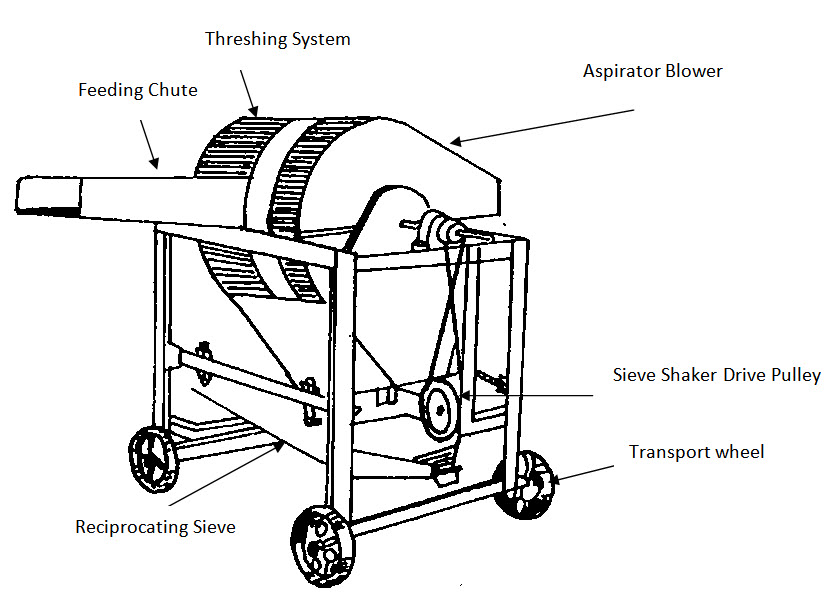
Fig. 1: Details of wheat thresher.

Threshing Unit: The threshing is accomplished by the impact of the rotating pegs mounted on the cylinder, over to the ear heads, which force out the grain from the sheath holding it. In the threshing of wheat crop, the straw is also bruised and broken up by the impact, thus converting it into ‘bhusa’ (straw). Threshing unit is mainly consists of a cylinder and concave. There are different types of threshing cylinders (Fig. 3) such as:
- Spike tooth/peg type cylinder
- Rasp bar type cylinder
- Angled bar type cylinder
- Wire loop type cylinder
- Cutter blade or syndicator type cylinder
- Hammer mill type cylinder
Spike tooth type cylinder: In this type of threshing drum, there is a hollow cylinder, made out of MS flat. Over to its entire periphery, a number of spikes/pegs of square /round bars or flat iron pieces are welded or bolted. Now days, in most of threshers, round peg with adjustable length are used. These spikes are staggered on the periphery of the drum for uniform threshing. The crop is fed along with the direction of motion of the rotating drum. The spike tooth cylinders are available in various sizes. A spike tooth cylinder with spikes of flat front and streamlined back has lower energy consumption.
Rasp bar type cylinder: In this type of cylinder, there are slotted plates, which are fitted over to the cylinder rings, in such a way that the direction of slot of one plate is opposite to another plate. This type of cylinder is commonly used in threshers. It gives better quality of bhusa and it can be used for a wide variety of crops viz.-wheat, paddy, maize, soybean etc.
Wire loop type cylinder: In this type of threshing drum, there is hallow cylinder, over which a number of wooden or MS plates are fitted. On these plates, number of wire loops is fixed for threshing purposes. This type of cylinder is common in the manually operated paddy threshers. Holding the bundle against the loops of revolving cylinder does threshing of paddy crop.
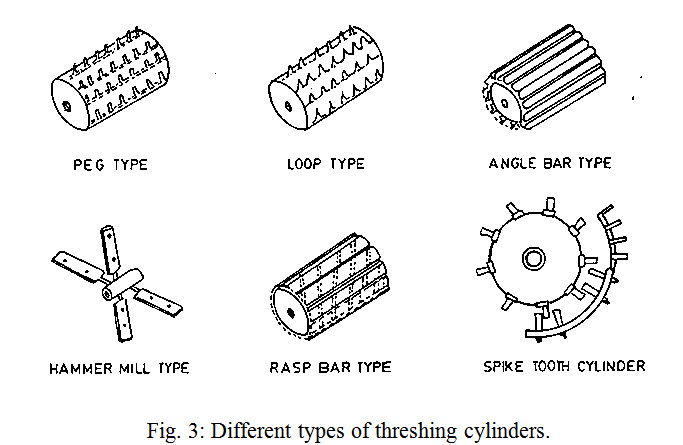
Chaff cutter/Syndicator type thresher:This is essentially an adoption of chaff cutter for threshing (Fig. 4). The crop is fed as is done in case of chaff cutters. After passing through a set of rollers, crop is cut into pieces. Varying the set of gears can vary the size. Three to four serrated blades are fastened on the radial arm of the flywheel. Threshing is done mainly due to cutting helped by rubbing and impact. The main advantage of syndicator thresher is that it can handle crop with higher moisture content. However, chopping knives need to be sharpened every 3-5 hours of operation. The machine is more prone to accidents due to positive feed rollers.
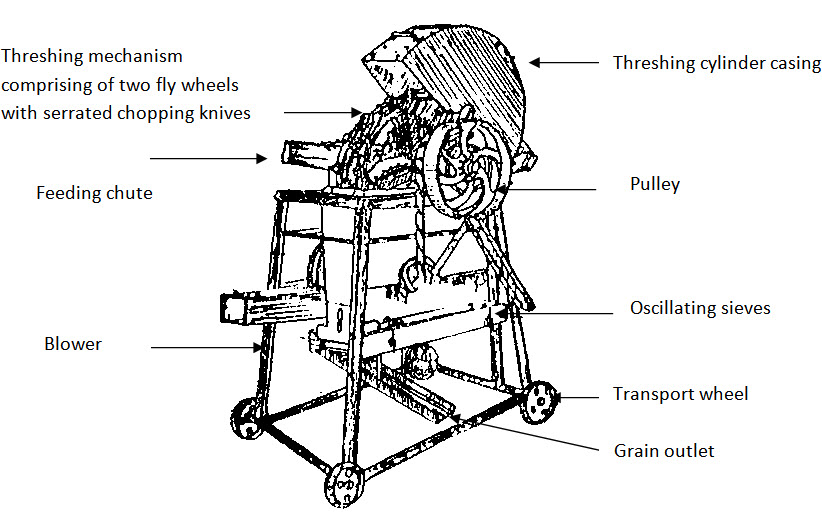
Fig. 4: Detail components of chaff cutter type thresher.
Hammer mill type cylinder: it uses beaters to do the required job of threshing. The shape of this type of cylinder is different from the above-discussed cylinder. The beaters are made of flat iron pieces and are fixed radically on the rotor shaft. Generally feeding chutes are used with hammer mill type threshing cylinder. The cut crop is fed perpendicular to the direction of motion of rotating beaters. This type of thresher requires more power as compared to spike tooth type of thresher.
Concave: Cylinder and concave together makes the threshing unit. It separates the grain from the crop and removes grain from the straw. Concave is provided in the thresher to hold the fed crop inside the threshing chamber and allows only grain and small amount of chaff to pass through it. The threshing takes place only in this space. It is a curved unit, made of iron steel or iron bar, fitted near the threshing cylinder. The clearance between cylinder and concave is adjustable, depending upon the size and type of grain. The concave clearance for wheat is 5 to 13 mm and for paddy is 5 to 10 mm. As the concave clearance is reduced, the threshing efficiency increases but losses increase and vice versa. The concave clearance at the inlet is less as compared to outlet. There are different types of concave, which are used in thresher.
Screen type concave: It is made of MS rod. It is semicircular in shape and sometimes made with wire also. The screen allows the material after threshing to pass through its perforation.
Perforated concave: In this, perforations are made in a mild steel sheet. The concave is closed from both the ends by iron sheet. The size of perforation is made as per the size of grain of a crop.
Cleaning unit: This unit is provided to separate the grain from chaff. It further uses sub units, like aspirators or blowers, sieves and sieve shaking mechanisms to separate out grains from chaff. The thresher that is provided with aspirator unit is usually called aspirator type thresher. Those threshers fitted with blower which blows air in horizontal direction is called drummy threshers.
Blower or Aspirator: After threshing unit carries out threshing, the cleaning and separation of straw from grain is required. The fan is generally installed on the main shaft over which cylinders, flywheel and driven pulley are mounted. Fan lifts/sucks the lighter material chaff and other plant portion and throw away from the out let. Rest of the separation-cum-cleaning is done by screen with its oscillating motion.
Screens: Most of the power threshers are equipped with two screens. Top screen is provided so as to pass the grain to second screen and chaff etc is taken out from it. Other screen sieves out the smaller grain or weeds seeds and delivers the cleaned grain towards outlet. The size of screen hole is selected on the basis of grain size. These screens are effective when kept under oscillation.
Shaking mechanism: The screens are oscillated or shaken with a crank attached to the screen. This crank is powered from main axle either by belt or by rod. The circular motion of the main shaft is converted into oscillating motion of screen, which shakes it and separates the grain from other foreign material and chaff. The separating effectiveness depends on the frequency of strokes of crank, which is adjustable.
Power transmission unit: Threshers are usually powered with tractors and sometimes with electric motors or diesel engine also. After installing the thresher into the threshing floor in the field, tractor PTO shaft is coupled with a flat pulley. A corresponding matching pulley of appropriate size is provided over to the thresher main shaft. These pulleys are connected with a proper rating of flat belt and thresher is operated. Blower fan is provided into the main shaft of the thresher, which rotates and does the required job. The screens are oscillated with the help of a v-belt and a crank wheel, powered with main shaft of thresher. A heavy flywheel is also provided on the main axle of the thresher. It is very important part of any thresher. It is provided to store the energy to supply continuously and equally to the entire threshing cylinder. It is made up of cost iron, and fitted on one end of the main shaft of thresher.
Main frame: A very strong frame is provided in the thresher on which all the functional parts are attached. The frame is made usually of heavy angle iron sections. It should be strong enough to sustain vibrations of machine, during its operation in the field.
Transport wheels: Thresher is provided with wheels at its legs, so that transportation can be done easily. These wheels are made mostly with cost iron but new and large capacity threshers are equipped with pneumatic wheels for better performance during transportation.
Thresher ddjustments: The following adjustments can be done on a stationary power thresher:
Cylinder and concave clearance: In order to get cleaned grains and proper threshing, it is very important to set the proper clearance between tip of cylinder and concave. On an average, concave clearance is kept about 25 mm at the mouth, 10 mm at the middle and 15 mm at the rear end. Start operating the thresher, by keeping proper recommended speed, and check if any grain is left in the ears. If it is so, reduce the concave clearance gradually, until drum is threshing cleanly. Too close concave setting is likely to crack some of the grains.
Cylinder speed: The drum of the thresher should be rotated at proper speed for better threshing and cleaning efficiency. Normally, manufacturers specify the cylinder speed for different crops. The cylinder speed can be checked using tachometer. Operator should check the speed occasionally under load for proper functioning of thresher. The cylinder peripheral speed for wheat is kept between 1520 to 1830 m/min and for paddy between 370 to 920 m/min.
Fan adjustment: Fan(s) fitted on thresher must provide the proper amount of blast. The shutter(s) at each end of fan should be adjusted properly so that it could provide blast sufficient enough to remove chaff and light materials without grain. Watching the sample and adjusting the blast can help in getting the desired results.
Drummy Thresher: These threshers were very popular in the beginning when threshers were introduced because of its simplicity and low cost. The radially arranged arms known as beaters are mounted on the shaft (Fig. 5). These are made of mild steel square section with mild steel flat welded or bolted at the top. The beaters revolve inside an enclosed casing. Ribs are provided inside of upper half of the cover in order to have better threshing. The lower half (known as concave) has rectangular openings made out from square bars. The crop is fed through feeding chute. Crop receives impacts from the rotating beaters till size is reduced to pass through concave. The clearance between beater and concave is kept about 18-20 mm. The crop should be well dried before feeding in the thresher. A wet crop raps around the beater shaft and machine becomes overloaded. These threshers do not have provision for separation and cleaning of grains. The threshed material is later separated and cleaned by small pedal type blower.

Fig. 5: Beater type drummy thresher.
Olpad thresher: ‘Olpad’ threshers (Fig. 6) are also used for threshing wheat crop. A pair of bullocks pulls it around over the dried crop spread in a circular form on the threshing ground. Threshing is continued till the entire material becomes a homogeneous mixture of grain and ‘bhusa’ (chaff). It consists of about 20 circular grooved discs each of 45-cm diameter and 3-mm thickness placed 15 cm apart in three rows. An operator’s seat is provided on the frame to control the movement of animals. All discs are mounted staggered to give more effective cutting of the straw. It has 3 or 4 wheels to facilitate its movement from one place to other. Threshing by this thresher is fairly efficient and cheap but is quite slow with low output capacity. This machine can be used for threshing wheat, barley, gram etc.
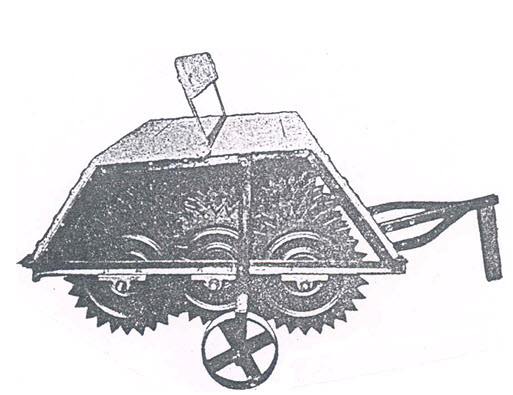
Fig. 6: Olpad thresher
Paddy Threshers: Paddy thresher of pedal operated type (Fig. 7) consists of mainly a well-balanced cylinder with a series of wire loops fixed on wooden slates. It has got gear drive mechanism to transmit power. While cylinder is kept in rotary motion at high speed, the paddy bundles of suitable sizes are applied to the teeth. The grains are separated by combining as well as by hammering action of threshing teeth. Paddy is threshed due to impact and rubbing action between threshing drawn loops and concave screen. The grains are cleaned with the help of a fan and cleaned grain goes down through the grain outlet at the bottom of the thresher. They are available in different horse power range.

Fig. 7: Pedal operated paddy thresher.
Multi-crop Threshers: Since, the Indian farmers raise variety of crops as per the suitability of particular region, climate and soil conditions, there was need to thresh all these crops for timelines of operation. Developing a multi crop thresher has solved this problem. It can thresh crops like wheat, moong, paddy, grain, soybean etc. For these crop requirements are different, as in the case of wheat bruised straw (bhusa) is the main requirement. For paddy, farmers need long straw. For pulses, seed damage should be minimal; as damaged seeds lower the quality and causes spoilage in storage. The crop factors such as moisture content, grain size, grain-straw ratio, condition of straw etc influence the design consideration of main components of threshers. The farmer is primarily interested in end product, low cost, durable and reliable machine. The suitable multi crop threshers for cereals and pulses are commercially available in the country.
A multi-crop thresher (Fig. 8) attains the axial movement of the crop while handling paddy and all crop material is made to move through the concave in case of wheat. The main components of multi-crop threshers are: feeding chute, threshing cylinder, aspirator blower, paddy chaff outlet, wheat straw outlet, hopper, and cam for oscillating sieves, oscillating sieves, transport wheel, frame, main pulley and louvers. The axial flow of material can be accomplished by providing seven louvers with spacing of 150 mm in the hexagonal casing. The clearance between louvers and tip of cylinder spikes is 20 mm. For wheat threshing, the first three louvers are placed with ribbed casing and side plates are fixed with top casing and concave to prevent material flow in the second portion. The direction of rotation of threshing cylinder is opposite for wheat than paddy. That is why; straw outlet of aspirator blower is repositioned. The top sieve has holes of 9-mm diameter for wheat and 5 mm for paddy grains. The lower sieve has holes of 1.5-mm diameter common for both the crops. The upper sieve can be changed easily depending upon crop to be threshed. The cylinder-concave clearance in the first section of threshing system (i.e. facing the feeding chute) has to be more while handling paddy than wheat. The machine output is 500 kg/h for wheat and 700 kg/h for paddy.
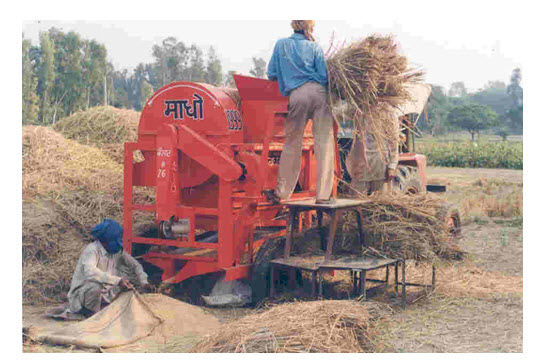
Fig. 8: Axial flow paddy thresher.
High capacity (Harambha) threshers: It is a basically a chaff-cutter type thresher. It consists of a threshing cylinder, concave, two aspirator blowers, reciprocating sieves, feeding chute, feeding conveyor, feed rollers, safety lever in the feeding chute and flywheel. A platform is attached to the main frame of thresher, on which a person stands and feeds the crop into thresher. All the crop materials are fed through the conveyor of feeding chute and feed rollers move the crop into threshing cylinder. A safety lever provided in feeding chute prevents the entrapping of hands by the feed rollers. Threshing cylinder has two chaff-cutter type blades and beaters. Chaff-cutter blades cut the crop into pieces and beater helps to detach grain from crop. All the threshed materials pass through the concave where it is subjected to aspiration action of blower. Light materials like chopped straw are blown away and grain etc. fall on a set of reciprocating sieves. The clean grain is collected in trolley through auger elevator. It can be used to thresh the crop having high moisture content also. The machine is operated by PTO of a 35-hp tractor and is mounted on two pneumatic tyres for easy transportation. It can thresh 1.5-2.0 tonnes/h.
Sunflower thresher: It consists of a threshing cylinder, concave, casing fitted with louvers, cleaning system, feeding hopper and frame (Fig. 9). The cylinder concave clearance is 40 mm and is uniform throughout its length. The diameter of cylinder is 65 cm and length 150 cm. The first part of cylinder of length 133 cm has flat bars for crop threshing and the 2nd portion of length 17-cm has straw throwing blades. The cylinder casing is of hexagonal shape and is fitted with 7 louvers. The louvers help the crop to move axially and the crop is rotated three and half times for complete separation of grains. The cleaning system has a blower and two sieves. The opening of top sieve is 16 mm and of lower sieve 6 mm. Recommended cylinder and blower speeds are 300-350 rpm and 1200-1400 rpm respectively. A tractor or 7.5 hp motor can operate machine. The machine has a capacity of 600-900 kg/h of clean grain.
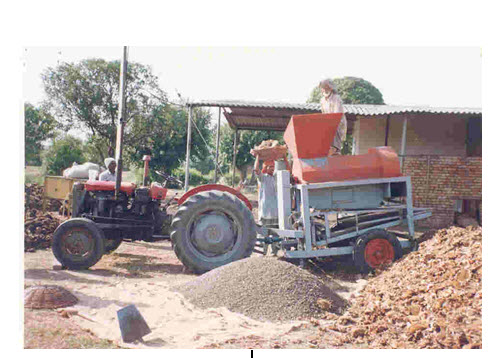
Fig. 9: Sunflower thresher in operation.